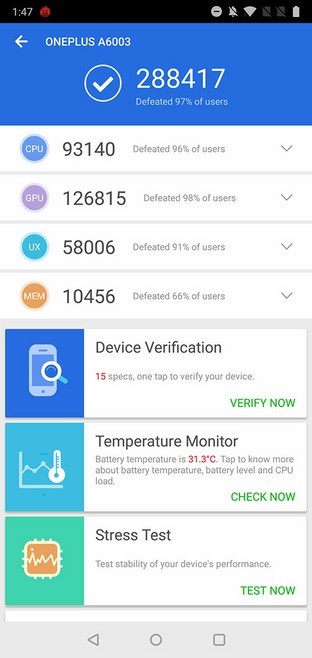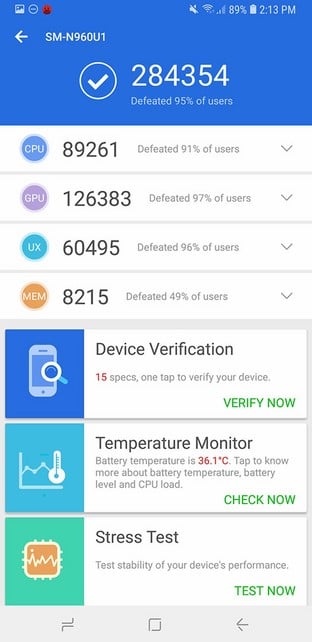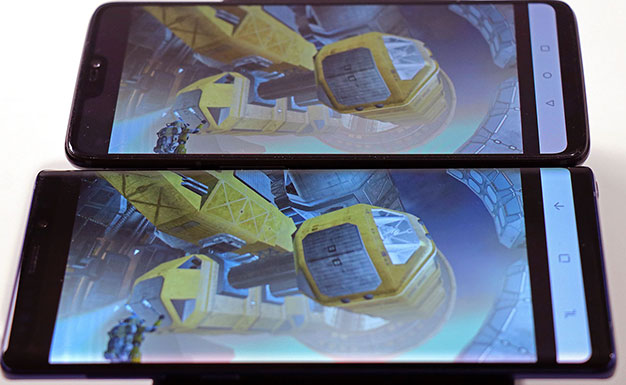
If there's one bit of messaging we keyed on, with respect to
Samsung's recently announced
Galaxy Note 9 flagship and its high-level feature set, it was the promise of a robust thermal solution that would maintain performance over time and under pressure. Samsung claims the new
Galaxy Note 9 employs a "water-carbon cooling" system, with a heat spreader for its
Snapdragon 845 SoC and associated circuitry, that's three times larger than the previous generation Galaxy Note.
So we figured we'd like to put that to the test. Meanwhile, we've also been spending quality time in the test lab with none other than the
OnePlus 6 -- an Android superphone in its own right, with 8GB of RAM and a near bone-stock Android 8.1
Oreo setup. What better to throw-down with? And so, we did...
Let's run-down the the key specifications and setup, so everyone knows what the contenders are made of and set the stage here:
- OnePlus 6: Snapdragon 845 - 8GB RAM, 128GB Storage, 3300 mAh Battery, 6.28" Display
- Galaxy Note 9: Snapdragon 845 - 6GB RAM, 128GB Storage, 4000 mAh Battery, 6.4" Display
- Fresh Boot-up, NFC and BT turned off, DND mode on, WiFi on, 5 minute idle before test runs
Is this an
apples-to-apples comparison, so to speak? Not really, if we're splitting hairs. Our OnePlus 6 (
retails for $579) is setup with 8GB of RAM, though it has the same core processing engine and storage complement. The Galaxy Note 9 we're testing has 6GB of RAM, though it's a healthy offering versus the myriad of 4GB Android phones out there right now. Regardless, our particular OnePlus 6 has a memory advantage at 8GB, or perhaps disadvantage, when it comes to power consumption and maybe some small level or thermal output. Either way, with both of these top-end Android handsets at the ready, let's see how Samsung's new Galaxy Note 9 holds up to its marketing claims of sustained performance for gaming, and otherwise, over extended use.

 OnePlus 6 8GB RAM (Left/Top) - Galaxy Note 9 6GB RAM (Right/Bottom) - First Run
OnePlus 6 8GB RAM (Left/Top) - Galaxy Note 9 6GB RAM (Right/Bottom) - First Run
This is our first run with both devices. As you can see, the OnePlus 6, generally speaking, has a small edge over the
Galaxy Note 9, with the exception of the UX test, where it falls behind (surprisingly) and the Memory test, where it posts a sizable lead over the Note 9. We should point out the Memory test lead here for the OnePlus 6 may or may not be due to its extra RAM because its RAM score was just on par with the Note 9, but its ROM score was markedly higher. This could be since it actually had to fetch from storage less often with 2 more Gigs of RAM on board, but we digress. Let's look at the 4th run in for these two Android titans.

 OnePlus 6 8GB RAM (Left/Top) - Galaxy Note 9 6GB RAM (Right/Bottom) - Fourth Run
OnePlus 6 8GB RAM (Left/Top) - Galaxy Note 9 6GB RAM (Right/Bottom) - Fourth Run
Here the
OnePlus 6 bleeds off anywhere from 4 to 7 percent of its performance, depending on whether you consider CPU or GPU scores. The Samsung Galaxy Note 9, however, is virtually unphased, showing only a marginal loss and actually within the variability window associated with the AnTuTu benchmark itself. Let's look at thermals...

 OnePlus 6 8GB RAM (Left/Top) - Galaxy Note 9 6GB RAM (Right/Bottom) - Thermals
OnePlus 6 8GB RAM (Left/Top) - Galaxy Note 9 6GB RAM (Right/Bottom) - Thermals
We've heard reports that Samsung's
Galaxy Note 9 puts up thermal images that are similar to other large format Android flagship phones. Based on the thermal performance graphed over time, at least with this one benchmark (AnTuTu), we would have to concur. Also, anecdotally, in our next round of testing with 3DMark, we would offer that both the Galaxy Note 9 and OnePlus 6 got rather warm to the touch on their rear side casing. They weren't "hot" per se, but we might classify them both as noticeably warm and under duress, which was to be expected.
Next we test
3DMark Sling Shot Extreme and again subject the two devices to four consecutive runs, with no rest in between. Let's see how the chips fall here...


 OnePlus 6 8GB RAM (Left/Top) - Galaxy Note 9 6GB RAM (Right/Bottom) - First Run
OnePlus 6 8GB RAM (Left/Top) - Galaxy Note 9 6GB RAM (Right/Bottom) - First Run
3DMark Sling Shot Extreme is a much more rigorous test, versus the mixed workloads of the general purpose AnTuTu
benchmark. This Android gaming benchmark pushes cutting-edge OpenGL ES 3.1 level graphics for impressive visuals. Once again, the OnePlus 6 is able to edge-out the
Samsung Galaxy Note 9. Frame rates aren't all that different and the lead is small, but consistent throughout.
But what about after the 4th run?

 OnePlus 6 8GB RAM (Left/Top) - Galaxy Note 9 6GB RAM (Right/Bottom) - Fourth Run
OnePlus 6 8GB RAM (Left/Top) - Galaxy Note 9 6GB RAM (Right/Bottom) - Fourth Run
Here we see more of the same, with the OnePlus 6 dropping about 8 - 10% of its graphics performance and total score here, while the Samsung Galaxy Note 9 is largely unaffected by the number of runs. We'll also note (no pun intended) that the 4th run seems to be a plateau for both devices, where thermal saturation has occurred and adding more runs didn't affect performance much. That's not to say that over hours of testing things might be different, but for our test purposes, the Samsung Galaxy Note 9 does seem to offer better performance over time and its thermal solution appears to be more robust.
That's not to say the OnePlus 6's performance is sub-par, however. In fact, quickly testing other devices in house,
like LG's G7 ThinQ, showed a significant if not worse drop-off with thermal throttling as well. And in fact, the
OnePlus 6 (full review incoming) is such a great performer and device overall (especially when you consider it's almost half the price of the Note 9 at $999 for our config), that we'll likely be heaping on some very high praise for it (based on what we've seen so far) when we publish its full review in the weeks ahead.
Regardless, kudos to Samsung for delivering on their performance claims with the new
Galaxy Note 9. Indeed, whether or not it runs warm really isn't the issue, so much as it maintains its performance over time rather admirably. Sure, it's a large device, though not all that much larger than the OnePlus 6. However, it did hang in much tougher, unwilling to give up its performance, benchmark run after run.
Stay tuned in the days ahead for our full review of the Samsung Galaxy Note 9...












